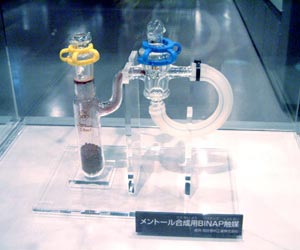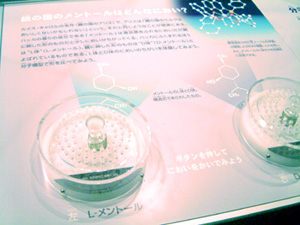Takasago Supplies Menthol for Exhibit at National Science Museum "New Annex''

The new annex of the National Science Museum in Tokyo, which opened to the public on November 2, is presenting an exhibit under the theme of "The History of Life on Earth ~ Human Beings in Coexistence with Nature," within which is featured selections from some of the latest fruits of scientific research. Showcased in "The Universe, Matter, and the Laws of Physics" corner of the exhibit are both the enantiomers of menthol prepared by means of asymmetric synthesis, l-isomer of which has been successfully industrialized by Takasago as a world first, together with the BINAP catalyst that made this breakthrough possible.
Menthol is the chief component for mint and peppermint, and is used in candies, tobacco, oral care items, pharmaceuticals and various other products. Takasago has researched more efficient methods to exclusively synthesize l-menthol alone over the years, and back in 1983 achieved a major advance in that field on the strength of an industry-academic alliance with Professor Ryoji Noyori (PhD and Nobel Laureate in Chemistry for 2001). This marked the world's first industrialization of l-menthol from naturally derived myrcene with catalytic asymmetric isomerization technology as the key step.

Among organic compounds, even with molecules for which identical types of atoms are bonded together in the same way, the stereostructures possess a relationship to each other resembling the "right hand" and "left hand" of people (levo isomers and dextro isomers). When artificially synthesizing this type of substance, the molecules on the left and right will have the same volume. Recent advances in technology make it possible to selectively synthesize either type, with the Museum exhibit introducing menthol as one example of this progress.
In the natural world, menthol exists only as levo isomer, while dextro isomer menthol fails to exhibit the aroma and refreshing flavor for which the substance is known. Asymmetric synthesis, which enables the exclusive selection of l-menthol alone, is a resource-conserving, high-efficiency "green chemistry" capable of the streamlined production of useful substances from lesser amounts of raw materials. 
In today's society, there are limits to the degree to which we can directly rely upon natural resources for the majority of functional substances. The truth is, therefore, that without chemical synthesis, in which high added value substances are generated on the strength of accumulated scientific knowledge, it would be impossible to maintain and manage our lives. This is particularly true with regard to substances that must be supplied in large volumes. On this front, technology rooted in the perspective of green chemistry - by definition, refined chemical conversion processes that are not only economical but also energy-efficient and eco-friendly - can be expected to provide a vital key for the chemical industry of the 21st century, not to mention the sustainable development and progress of society.
At Takasago, we currently apply this core technology to the production of l-menthol. In addition, we are also engaged in the development of the specialty products for cooling and warming derived from menthol, which are supplied to a wide range of manufacturers.

The National Science Museum recently requested Takasago for the supply of menthol samples, and we were more than happy to oblige. Now, at the Museum's "new annex," it is possible to actually sample and experience the different aromas of levo isomer and dextro isomer menthol.